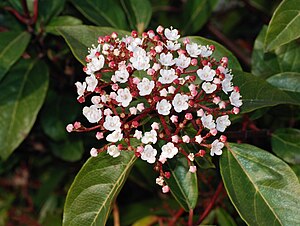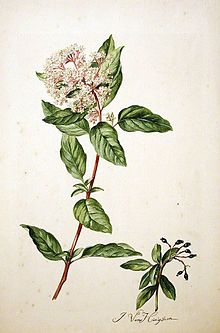Laurel-leaved viburnum
| Laurel-leaved viburnum | ||||||||||||
|---|---|---|---|---|---|---|---|---|---|---|---|---|

Laurel-leaved viburnum ( Viburnum tinus ) |
||||||||||||
| Systematics | ||||||||||||
|
||||||||||||
| Scientific name | ||||||||||||
| Viburnum tinus | ||||||||||||
| L. |
The Lorbeerblättrige snowball ( Viburnum tinus ), also laurel snowball , Evergreen snowball or Mediterranean snowball called, is a species in the genus snowball ( Viburnum ) within the family of adoxaceae (Adoxaceae).
description
The laurel-leaved viburnum is an evergreen shrub or small tree that reaches heights of up to 3.5 meters. The opposite leaves are simple, leathery and ovate to elliptical. The upper side of the leaf is glossy dark green and the underside of the leaf is hairy with glands. The leaf margin is smooth.
All flowers, which stand together in a flat, gold-like inflorescence , are fertile . The fragrant flowers are hermaphroditic and five-fold. The five sepals are fused. The five petals are fused tubular with spread out rounded corolla lobes and pink in the bud, later white. There is only one circle with five stamens . The stylus is short. The winter bloom time extends from November to April. The pollination is done by insects.
The solitary stone fruits are bluish-black when ripe.
distribution
Viburnum tinus is distributed throughout the Mediterranean, the Azores and Canaries and is naturalized in the British Isles.
The plants are partially hardy in Central Europe ( WHZ 7 to 8a ), but thrive in the open air with a wine-growing climate.
history
Pliny mentioned “Tinus” as a kind of laurel (“bacae caerulae” (Plin. 15,128–129)). Hieronymus Bock describes "Tinus" as "wild laurel tree" or otherwise as "Laurus Agria / Aria". Also Rembert Dodoens called the Lorbeerblättrigen snowball "Wild Laurus-boom, Laurus sylvestris". Until well into the 17th century, the species was classified as laurel because of its evergreen, leathery, glossy, entire-edged leaves and its shiny metallic fruits.
Systematics
The species name Viburnum tinus was first published in 1753 by Carl von Linné in Species Plantarum , 1, p. 267. The specific epithet tinus is based on the Latin word tinus for "stone laurel" due to an older name from Pliny until the 17th century .
One can distinguish three subspecies:
- Viburnum tinus L. subsp. tinus : It comes in Morocco, Algeria, Tunisia, Libya, Spain, Portugal, France, Mallorca, Corsica, Sardinia, Sicily, Italy, Slovenia, Albania, Greece, Crete, in the Aegean Sea, in Turkey, in the area of Lebanon and Syria and in the area of Jordan and Israel.
- Viburnum tinus subsp. rigidum (Vent.) P. Silva (Syn .: Viburnum rigidum Vent. ): It occurs in the Canaries. The chromosome number is 2n = 18.
- Viburnum tinus subsp. subcordatum (Trel.) P. Silva (Syn .: Viburnum tinus var. subcordatum Trel. ): It occurs in the Azores and in Portugal.
use
The laurel-leaved viburnum is often used as an evergreen ornamental plant in parks and gardens or as a container plant.
sorts
Some varieties have been selected by gardeners (selection):
- 'Eva Price': denser, more compact than the species
- 'Exbury Form': similar to 'Lucidum', but harder than this
- 'French White': strong growth and large white flowers
- 'Gwenllian': compact growth, numerous flowers
- 'Little Bognor': Flowers appear as early as August, quite hardy
- 'Lucidum': strong growth, sensitive to frost
- 'Pink Prelude': white flowers, later light pink to deep pink
- 'Purpureum': young leaves purple-green, later dark green, tinged purple
- 'Spirit': free flowering, flowers and fruits sometimes at the same time
- 'Spring Boquet': compact growth with brownish green leaves on the shoot
- 'Variegatum': creamy white to creamy yellow edged leaves, sensitive to frost
source
- Rubina Akhter: Viburnum tinus in the Flora of Pakistan : Online. (Section description)
- Andreas Bärtels: Encyclopedia of Garden Trees , Ulmer Verlag, Stuttgart 2001, ISBN 3-8001-3198-6 , p. 230.
- Dericks-Tan, Vollbrecht: On the trail of wild fruits in Europe . Abadi-Verlag 2009, ISBN 978-3-00-021129-4 , p. 259
Individual evidence
- ^ Viburnum tinus in the Germplasm Resources Information Network (GRIN), USDA , ARS , National Genetic Resources Program. National Germplasm Resources Laboratory, Beltsville, Maryland.
- ↑ IPNI
- ^ Robert Zander : Zander. Concise dictionary of plant names. Edited by Walter Erhardt , Erich Götz, Nils Bödeker, Siegmund Seybold . 17th edition. Eugen Ulmer, Stuttgart 2002, ISBN 3-8001-3573-6 , pp. 844-845.
- ↑ a b c d e E. von Raab-Straube (2017+): Viburnaceae. - In: Euro + Med Plantbase - the information resource for Euro-Mediterranean plant diversity. Data sheet Viburnum
- ↑ The natural history of Caius Plinius Secundus . Marixverlag, Wiesbaden 2007, ISBN 978-3-86539-144-5 , pp. 712-713
- ↑ Hieronymus Bock: Kreutterbuch 1577 , p. 375
- ↑ Rembert Dodoens: Cruydt-Boeck , 1644, pp 1329-1330.
- ↑ a b Helmut Genaust: Etymological dictionary of botanical plant names. 3rd, completely revised and expanded edition. Birkhäuser, Basel / Boston / Berlin 1996, ISBN 3-7643-2390-6 , p. 646.
- ↑ Carl von Linné: Species Plantarum , 1, 1753, p. 267 scanned in at biodiversitylibrary.org.
- ↑ Viburnum rigidum at Tropicos.org. In: IPCN Chromosome Reports . Missouri Botanical Garden, St. Louis
- ↑ Viburnum tinus as a useful plant in Plants for a Future.


